Xinhang Li
E4SRec: An Elegant Effective Efficient Extensible Solution of Large Language Models for Sequential Recommendation
Dec 05, 2023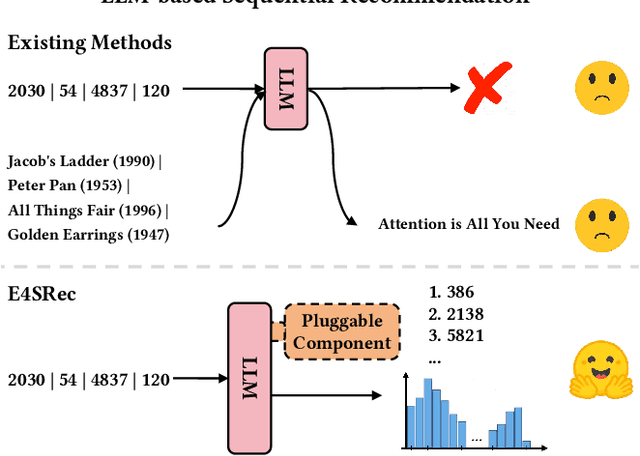
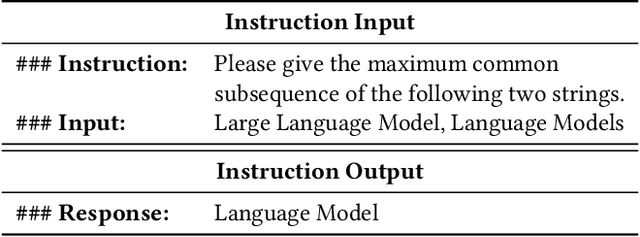
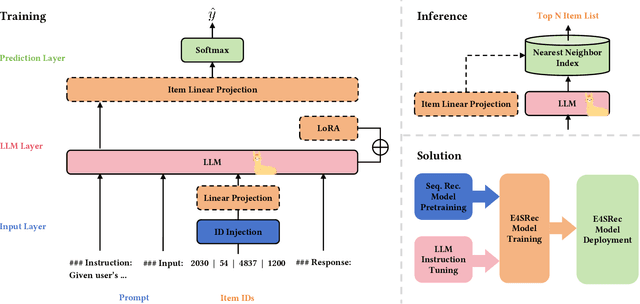

Abstract:The recent advancements in Large Language Models (LLMs) have sparked interest in harnessing their potential within recommender systems. Since LLMs are designed for natural language tasks, existing recommendation approaches have predominantly transformed recommendation tasks into open-domain natural language generation tasks. However, this approach necessitates items to possess rich semantic information, often generates out-of-range results, and suffers from notably low efficiency and limited extensibility. Furthermore, practical ID-based recommendation strategies, reliant on a huge number of unique identities (IDs) to represent users and items, have gained prominence in real-world recommender systems due to their effectiveness and efficiency. Nevertheless, the incapacity of LLMs to model IDs presents a formidable challenge when seeking to leverage LLMs for personalized recommendations. In this paper, we introduce an Elegant Effective Efficient Extensible solution for large language models for Sequential Recommendation (E4SRec), which seamlessly integrates LLMs with traditional recommender systems that exclusively utilize IDs to represent items. Specifically, E4SRec takes ID sequences as inputs, ensuring that the generated outputs fall within the candidate lists. Furthermore, E4SRec possesses the capability to generate the entire ranking list in a single forward process, and demands only a minimal set of pluggable parameters, which are trained for each dataset while keeping the entire LLM frozen. We substantiate the effectiveness, efficiency, and extensibility of our proposed E4SRec through comprehensive experiments conducted on four widely-used real-world datasets. The implementation code is accessible at https://github.com/HestiaSky/E4SRec/.
The NeurIPS 2022 Neural MMO Challenge: A Massively Multiagent Competition with Specialization and Trade
Nov 07, 2023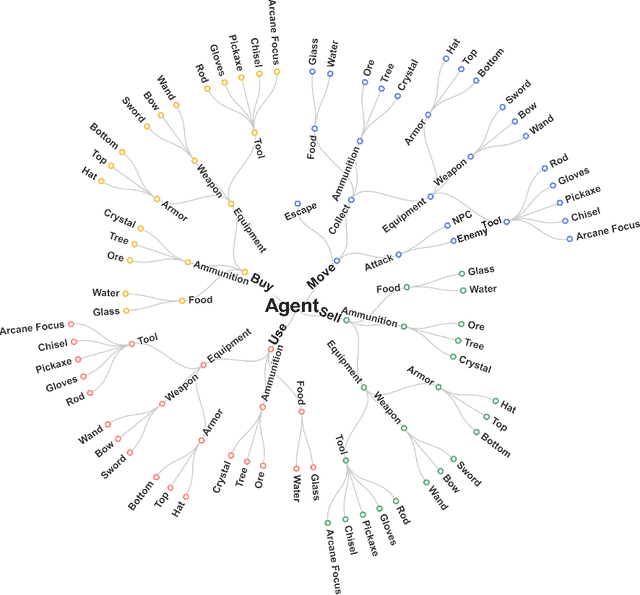



Abstract:In this paper, we present the results of the NeurIPS-2022 Neural MMO Challenge, which attracted 500 participants and received over 1,600 submissions. Like the previous IJCAI-2022 Neural MMO Challenge, it involved agents from 16 populations surviving in procedurally generated worlds by collecting resources and defeating opponents. This year's competition runs on the latest v1.6 Neural MMO, which introduces new equipment, combat, trading, and a better scoring system. These elements combine to pose additional robustness and generalization challenges not present in previous competitions. This paper summarizes the design and results of the challenge, explores the potential of this environment as a benchmark for learning methods, and presents some practical reinforcement learning training approaches for complex tasks with sparse rewards. Additionally, we have open-sourced our baselines, including environment wrappers, benchmarks, and visualization tools for future research.
Contrastive Graph Pooling for Explainable Classification of Brain Networks
Jul 07, 2023



Abstract:Functional magnetic resonance imaging (fMRI) is a commonly used technique to measure neural activation. Its application has been particularly important in identifying underlying neurodegenerative conditions such as Parkinson's, Alzheimer's, and Autism. Recent analysis of fMRI data models the brain as a graph and extracts features by graph neural networks (GNNs). However, the unique characteristics of fMRI data require a special design of GNN. Tailoring GNN to generate effective and domain-explainable features remains challenging. In this paper, we propose a contrastive dual-attention block and a differentiable graph pooling method called ContrastPool to better utilize GNN for brain networks, meeting fMRI-specific requirements. We apply our method to 5 resting-state fMRI brain network datasets of 3 diseases and demonstrate its superiority over state-of-the-art baselines. Our case study confirms that the patterns extracted by our method match the domain knowledge in neuroscience literature, and disclose direct and interesting insights. Our contributions underscore the potential of ContrastPool for advancing the understanding of brain networks and neurodegenerative conditions.
OpenSiteRec: An Open Dataset for Site Recommendation
Jul 03, 2023



Abstract:As a representative information retrieval task, site recommendation, which aims at predicting the optimal sites for a brand or an institution to open new branches in an automatic data-driven way, is beneficial and crucial for brand development in modern business. However, there is no publicly available dataset so far and most existing approaches are limited to an extremely small scope of brands, which seriously hinders the research on site recommendation. Therefore, we collect, construct and release an open comprehensive dataset, namely OpenSiteRec, to facilitate and promote the research on site recommendation. Specifically, OpenSiteRec leverages a heterogeneous graph schema to represent various types of real-world entities and relations in four international metropolises. To evaluate the performance of the existing general methods on the site recommendation task, we conduct benchmarking experiments of several representative recommendation models on OpenSiteRec. Furthermore, we also highlight the potential application directions to demonstrate the wide applicability of OpenSiteRec. We believe that our OpenSiteRec dataset is significant and anticipated to encourage the development of advanced methods for site recommendation. OpenSiteRec is available online at https://OpenSiteRec.github.io/.
Progression Cognition Reinforcement Learning with Prioritized Experience for Multi-Vehicle Pursuit
Jun 08, 2023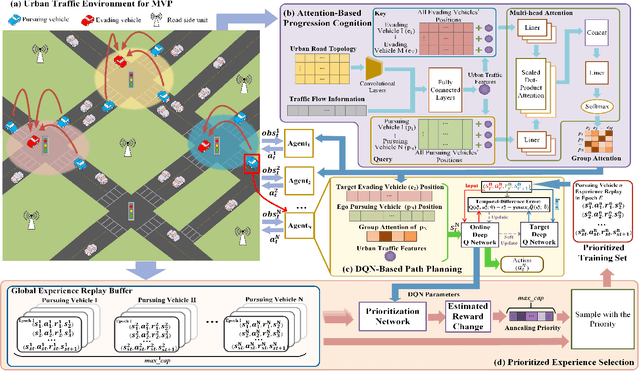
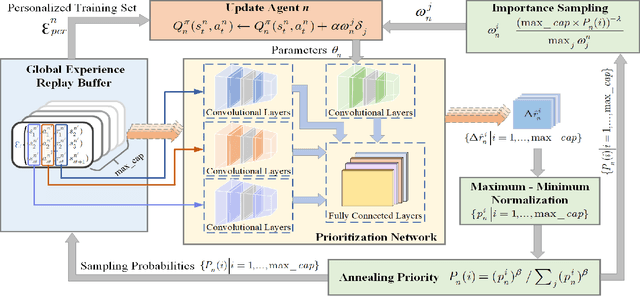


Abstract:Multi-vehicle pursuit (MVP) such as autonomous police vehicles pursuing suspects is important but very challenging due to its mission and safety critical nature. While multi-agent reinforcement learning (MARL) algorithms have been proposed for MVP problem in structured grid-pattern roads, the existing algorithms use randomly training samples in centralized learning, which leads to homogeneous agents showing low collaboration performance. For the more challenging problem of pursuing multiple evading vehicles, these algorithms typically select a fixed target evading vehicle for pursuing vehicles without considering dynamic traffic situation, which significantly reduces pursuing success rate. To address the above problems, this paper proposes a Progression Cognition Reinforcement Learning with Prioritized Experience for MVP (PEPCRL-MVP) in urban multi-intersection dynamic traffic scenes. PEPCRL-MVP uses a prioritization network to assess the transitions in the global experience replay buffer according to the parameters of each MARL agent. With the personalized and prioritized experience set selected via the prioritization network, diversity is introduced to the learning process of MARL, which can improve collaboration and task related performance. Furthermore, PEPCRL-MVP employs an attention module to extract critical features from complex urban traffic environments. These features are used to develop progression cognition method to adaptively group pursuing vehicles. Each group efficiently target one evading vehicle in dynamic driving environments. Extensive experiments conducted with a simulator over unstructured roads of an urban area show that PEPCRL-MVP is superior to other state-of-the-art methods. Specifically, PEPCRL-MVP improves pursuing efficiency by 3.95% over TD3-DMAP and its success rate is 34.78% higher than that of MADDPG. Codes are open sourced.
IMF: Interactive Multimodal Fusion Model for Link Prediction
Mar 20, 2023Abstract:Link prediction aims to identify potential missing triples in knowledge graphs. To get better results, some recent studies have introduced multimodal information to link prediction. However, these methods utilize multimodal information separately and neglect the complicated interaction between different modalities. In this paper, we aim at better modeling the inter-modality information and thus introduce a novel Interactive Multimodal Fusion (IMF) model to integrate knowledge from different modalities. To this end, we propose a two-stage multimodal fusion framework to preserve modality-specific knowledge as well as take advantage of the complementarity between different modalities. Instead of directly projecting different modalities into a unified space, our multimodal fusion module limits the representations of different modalities independent while leverages bilinear pooling for fusion and incorporates contrastive learning as additional constraints. Furthermore, the decision fusion module delivers the learned weighted average over the predictions of all modalities to better incorporate the complementarity of different modalities. Our approach has been demonstrated to be effective through empirical evaluations on several real-world datasets. The implementation code is available online at https://github.com/HestiaSky/IMF-Pytorch.
Graded-Q Reinforcement Learning with Information-Enhanced State Encoder for Hierarchical Collaborative Multi-Vehicle Pursuit
Oct 24, 2022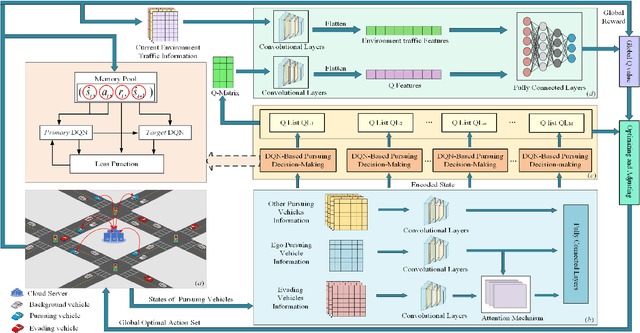
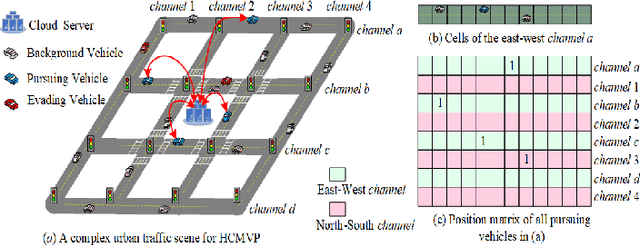
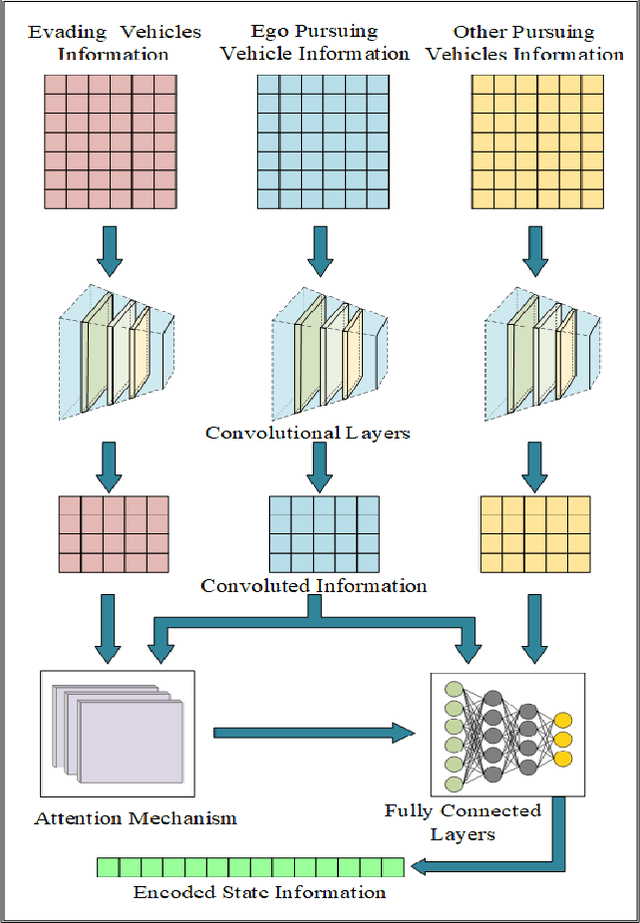
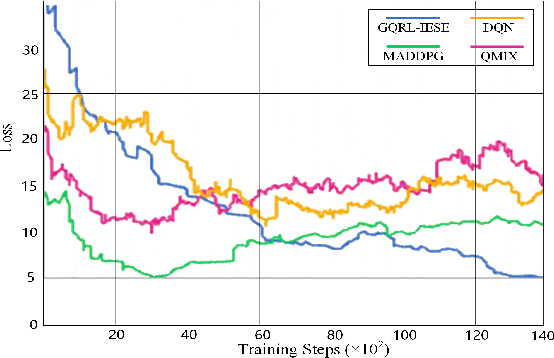
Abstract:The multi-vehicle pursuit (MVP), as a problem abstracted from various real-world scenarios, is becoming a hot research topic in Intelligent Transportation System (ITS). The combination of Artificial Intelligence (AI) and connected vehicles has greatly promoted the research development of MVP. However, existing works on MVP pay little attention to the importance of information exchange and cooperation among pursuing vehicles under the complex urban traffic environment. This paper proposed a graded-Q reinforcement learning with information-enhanced state encoder (GQRL-IESE) framework to address this hierarchical collaborative multi-vehicle pursuit (HCMVP) problem. In the GQRL-IESE, a cooperative graded Q scheme is proposed to facilitate the decision-making of pursuing vehicles to improve pursuing efficiency. Each pursuing vehicle further uses a deep Q network (DQN) to make decisions based on its encoded state. A coordinated Q optimizing network adjusts the individual decisions based on the current environment traffic information to obtain the global optimal action set. In addition, an information-enhanced state encoder is designed to extract critical information from multiple perspectives and uses the attention mechanism to assist each pursuing vehicle in effectively determining the target. Extensive experimental results based on SUMO indicate that the total timestep of the proposed GQRL-IESE is less than other methods on average by 47.64%, which demonstrates the excellent pursuing efficiency of the GQRL-IESE. Codes are outsourced in https://github.com/ANT-ITS/GQRL-IESE.
Confidence Estimation Transformer for Long-term Renewable Energy Forecasting in Reinforcement Learning-based Power Grid Dispatching
Apr 10, 2022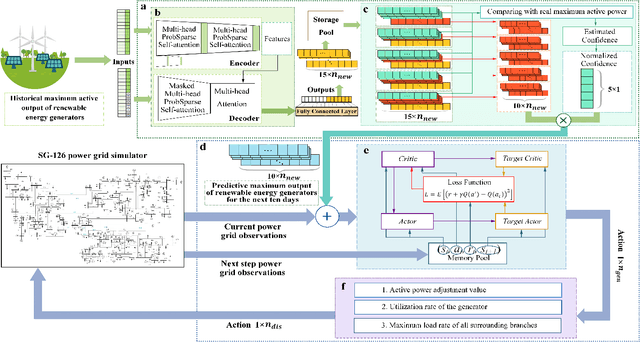
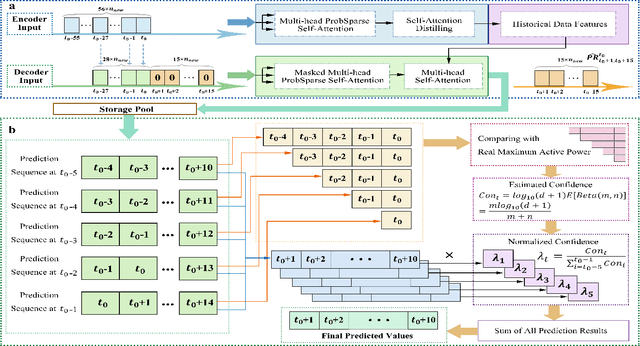
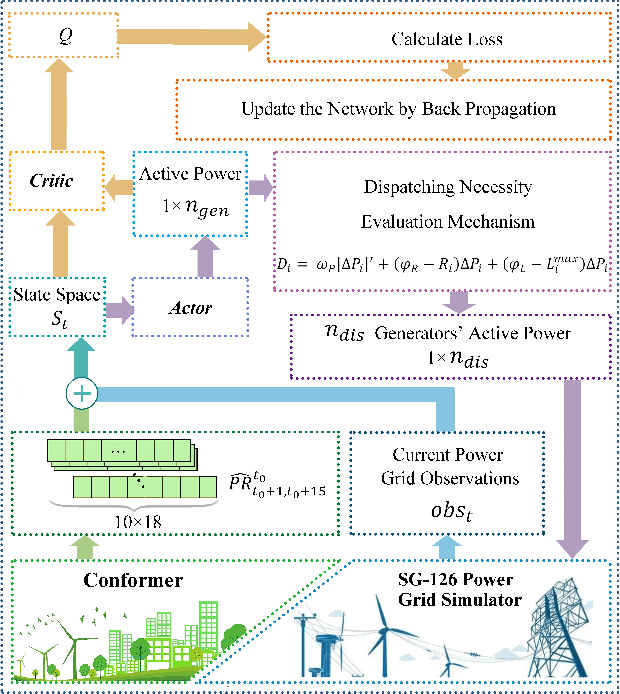

Abstract:The expansion of renewable energy could help realizing the goals of peaking carbon dioxide emissions and carbon neutralization. Some existing grid dispatching methods integrating short-term renewable energy prediction and reinforcement learning (RL) have been proved to alleviate the adverse impact of energy fluctuations risk. However, these methods omit the long-term output prediction, which leads to stability and security problems on the optimal power flow. This paper proposes a confidence estimation Transformer for long-term renewable energy forecasting in reinforcement learning-based power grid dispatching (Conformer-RLpatching). Conformer-RLpatching predicts long-term active output of each renewable energy generator with an enhanced Transformer to boost the performance of hybrid energy grid dispatching. Furthermore, a confidence estimation method is proposed to reduce the prediction error of renewable energy. Meanwhile, a dispatching necessity evaluation mechanism is put forward to decide whether the active output of a generator needs to be adjusted. Experiments carried out on the SG-126 power grid simulator show that Conformer-RLpatching achieves great improvement over the second best algorithm DDPG in security score by 25.8% and achieves a better total reward compared with the golden medal team in the power grid dispatching competition sponsored by State Grid Corporation of China under the same simulation environment. Codes are outsourced in https://github.com/buptlxh/Conformer-RLpatching.
Jointly Learning Knowledge Embedding and Neighborhood Consensus with Relational Knowledge Distillation for Entity Alignment
Jan 25, 2022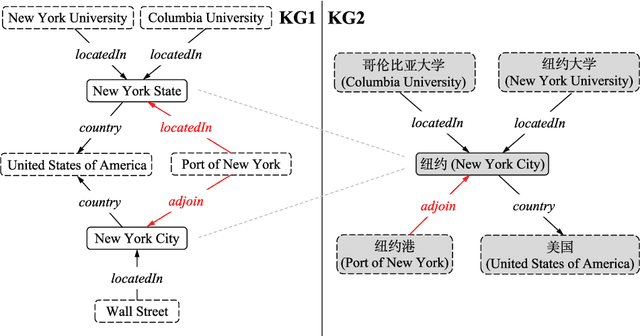
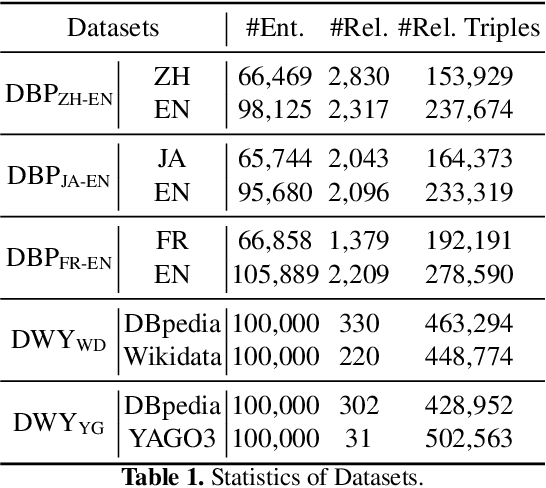
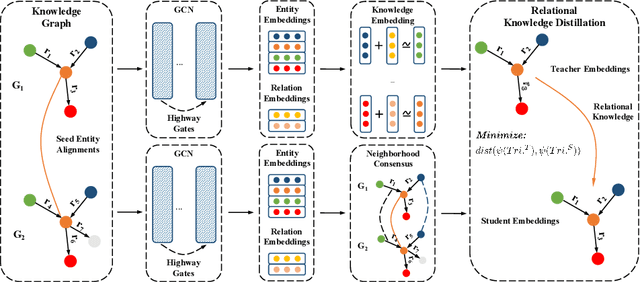
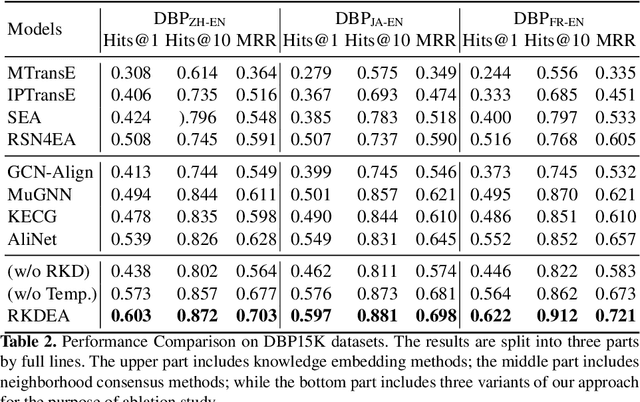
Abstract:Entity alignment aims at integrating heterogeneous knowledge from different knowledge graphs. Recent studies employ embedding-based methods by first learning the representation of Knowledge Graphs and then performing entity alignment via measuring the similarity between entity embeddings. However, they failed to make good use of the relation semantic information due to the trade-off problem caused by the different objectives of learning knowledge embedding and neighborhood consensus. To address this problem, we propose Relational Knowledge Distillation for Entity Alignment (RKDEA), a Graph Convolutional Network (GCN) based model equipped with knowledge distillation for entity alignment. We adopt GCN-based models to learn the representation of entities by considering the graph structure and incorporating the relation semantic information into GCN via knowledge distillation. Then, we introduce a novel adaptive mechanism to transfer relational knowledge so as to jointly learn entity embedding and neighborhood consensus. Experimental results on several benchmarking datasets demonstrate the effectiveness of our proposed model.
A Credibility-aware Swarm-Federated Deep Learning Framework in Internet of Vehicles
Aug 09, 2021



Abstract:Federated Deep Learning (FDL) is helping to realize distributed machine learning in the Internet of Vehicles (IoV). However, FDL's global model needs multiple clients to upload learning model parameters, thus still existing unavoidable communication overhead and data privacy risks. The recently proposed Swarm Learning (SL) provides a decentralized machine-learning approach uniting edge computing and blockchain-based coordination without the need for a central coordinator. This paper proposes a Swarm-Federated Deep Learning framework in the IoV system (IoV-SFDL) that integrates SL into the FDL framework. The IoV-SFDL organizes vehicles to generate local SL models with adjacent vehicles based on the blockchain empowered SL, then aggregates the global FDL model among different SL groups with a proposed credibility weights prediction algorithm. Extensive experimental results demonstrate that compared with the baseline frameworks, the proposed IoV-SFDL framework achieves a 16.72% reduction in edge-to-global communication overhead while improving about 5.02% in model performance with the same training iterations.
 Add to Chrome
Add to Chrome Add to Firefox
Add to Firefox Add to Edge
Add to Edge